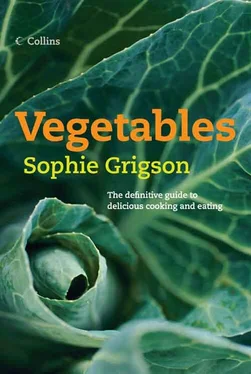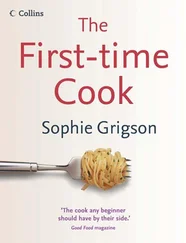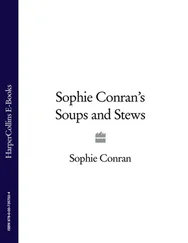Publisher’s acknowledgements
Thank you to North Aston Organics for their help with photography of vegetables, and The Conran Shop and Harrods for the loan of props.
There is one important element of vegetable preparation that I have omitted from the individual entries for fear of tedious repetition: unless they are to be peeled, all vegetables should be rinsed before use. Beautiful earthy potatoes and other roots will obviously need to be scrubbed as well, so a vegetable brush is an essential piece of equipment. A nail brush fits the purpose well enough, but make sure that everyone in your house knows and respects the fact that it is only to be used for vegetables, and not to scrub engine oil or paint off soiled hands.
In most instances, precise measuring of ingredients is not absolutely necessary. Take vegetable quantities as rough guidelines. Unless you are making something like the carrot cake on page 28 or the potato cakes on page 73, a little more or a little less will not ruin a dish. There is no point wasting a quarter of a potato, when following a recipe for mash, for instance.
On the whole, it makes sense to stick with either imperial or metric measurements. It makes life simpler, if nothing else. I often suggest using handfuls of this or that. Some people find this frustratingly vague, but it allows whoever is using the recipe to make their own decisions about the final strength of flavours in a dish. Ingredients, particularly herbs and vegetables, vary greatly from one batch to another, from one season to another. As cooks, we have to take this in our stride, adding a little bit more here, a little bit less there in order to compensate for fluctuations in flavour.
Unless otherwise specified, eggs are always free range and always large. Spoon measurements are rounded. I use a standard 15 ml tablespoon, 10ml dessertspoon and 5ml teaspoon. Recipes that include olive oil will taste better if made with extra virgin olive oil. Herbs are all fresh, with the exception of bay leaves (good fresh or dried) and dried oregano (use the fabulous Greek rigani, dried wild oregano, if you can get it), which is more exciting than fresh. Pepper and nutmeg should always be freshly ground to maximise spicy impact.
Finally, remember that suggested cooking times are not absolutes. Every oven has its own individual quirks, and settings vary. Similarly the width and make-up of saucepans will affect cooking times. So, check foods regularly as they cook, and if they look done, smell done, taste done, they probably are.
Roots
I’d like to serenade the beetroot. Thank your lucky stars then that this is a book, and you can’t hear me try. Tunefulness was never my strong point. The fact is, though, that beetroot is a miraculous vegetable. Despite extraordinary maltreatment (what else would you call boiling the poor things in vats of malt vinegar?) the beetroot has re-emerged in recent years as something of a star. It features on the menus of the most elevated of restaurants, and it appears regularly in the smartest recipe books, regaining its rightful reputation as a truly delicious, unique vegetable. What other vegetable can offer the combination of full sweet, earthy flavour together with the rich purple-red of a classic beetroot?
If the foregoing leaves you bewildered, it may just be that you have never tasted beetroot at its finest. In other words, home-roast beetroot, cooked slowly to preserve its true flavour. Sure, you can save time and buy it ready-cooked in neat little vacuum packs, but it will have already lost so much to the processing that it is hardly worth the bother. Sure, you can save time and boil your beets in a large pan of water, but again, so much flavour flows out that you end up with a dumbed-down version.
The classic dark purple, staining beetroot is not the only form of the vegetable in existence. The colourways can vary from the palest whitespattered with rose, to the summery hue of golden beetroot. Although both occasionally wander on to the shelves of smart greengrocers, or even the better supermarkets, they are hardly common fare. You are more likely to come across them at a farmers’ market. Or, of course, you could grow them yourself and enjoy them pulled straight from the ground, golf-ball sized. Is the taste of these golden beets different? A little, I think, though not radical enough to make headline news. The colour is the main attraction plus the fact that the juice doesn’t stain clothing to anything like the same extent.
If possible, buy beetroot by the bunch, complete with leaves. The leaves are the best indicator of freshness. When they are crisply firm, squeaky in their perfection, you know that the beetroot has come out of the ground recently. As it happens, these telltale leaves are also rather good to eat. Like some earthily rich form of spinach, they can be stir-fried or blanched and served up with a knob of butter melting over them, or Italian-style with a slick of olive oil and plentiful freshly squeezed lemon juice. Or, chop fine and use in a stuffing for ravioli. They’re good, too, treated like kale, blanched and fried up with crisp, salty bacon.
As for the beets themselves, only buy them if they are firm with taut skins. Any suggestion of softness or wrinkles tells you that they are older than they should be. It’s one thing for you to keep them hanging around in your vegetable drawer for a few days, but it’s not on for the retailer to palm off old stock on you. It is rare to have much option over size, but if you do, choose medium-sized ones over large, for a gentler, but never wimpy, taste. Snap up teensy beetroots whenever you get the chance, for these are the choicest of all, with a marvellous sweetness and silky-smooth texture when cooked.
Although it is not the only way to cook beetroot, by far the best general method is to roast them, guarding all their juiciness and flavour. For most purposes, the process is as follows: wash the beetroots well (but don’t scrub brutally, which will rupture the skin) and trim off the leaves, leaving about 2 cm ( 3/ 4in) of stalk in place to minimise bleeding. Do not trim off the root. Wrap each beetroot individually in foil, place in a roasting tin or ovenproof dish and slide into a preheated oven. For the finest results the temperature should be fairly low – say around 150°C/300°F/Gas 2. You should allow 2–3 hours for the beetroots to cook. They will still turn out well at a higher temperature if you want to speed matters up a little, or have something else cooking in the oven – anything up to 200°C/400°F/Gas 6 will do nicely. To test, unwrap one of the larger beetroot and scrape gently at the skin near the root. When it comes away easily, the beetroots are done. Take them out and cool slightly, then unwrap and skin each one.
I don’t boil beetroot, although many people would cook it no other way. Boiling introduces a wateriness that diminishes the joy of good beetroot. If you want to speed up the cooking process, then I would suggest that you think of peeling and cutting up raw beetroot into smaller pieces (say 2–3 cm/1 in cubes), then roasting in a hot oven, tossed with a little olive oil, salt, pepper and some whole garlic cloves and sprigs of thyme, or a good sprinkling of fennel seeds or dill seeds. As with most roast vegetables, they’ll need some 40–60 minutes in the oven – cook uncovered, turning occasionally and adding a little water or orange juice if you think they look worryingly dry. It may be necessary to cover the dish with foil towards the end of the cooking time if the chunks of beetroot are still not quite tender. Sautéed beetroot is also surprisingly delicious – make the cubes a little smaller, say 1–1.5cm ( 1/ 2in) across, and sauté them in olive oil or sunflower oil until tender.
Читать дальше












